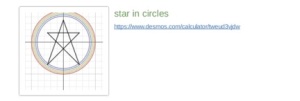Last week I introduced my students to Desmos. After doing a short lesson to show off the power and “what-if” capabilities of desmos, I pretty much let them loose on creating equation-driven art. My main objective here was for students to get a deeper understanding of linear equations, and specifically more experience with restricting the domain and/or range of a linear equation. So I showed the students how to restrict the domain and range, and my only requirement of the art is that they include at least one instance of a restricted domain/range. Very soon the kids wanted to know how to create and manipulate parabolas, circles, sine waves, etc. The students absolutely loved this activity; I was hearing comments like “Desmos is the best app I ever”, and “oh, now I see how that works”. I gave them two class periods to work on their art, and told them they can complete it at home and save it to the google folder they have shared with me. Here’s some of the artwork I received back. This first one, the Hunger Games’ Mockingjay uses 40 equations and the student worked on it for over 3 hours.
To see Mockingjay in all its glory in Desmos: https://www.desmos.com/calculator/ihxor3kijv
To see butterfly in Desmos: https://www.desmos.com/calculator/zwmkq6gxx5
To see Birds by the Sea in Desmos: https://www.desmos.com/calculator/poq9oyptce
To see star in circles in Desmos: https://www.desmos.com/calculator/tweud3vjdw





